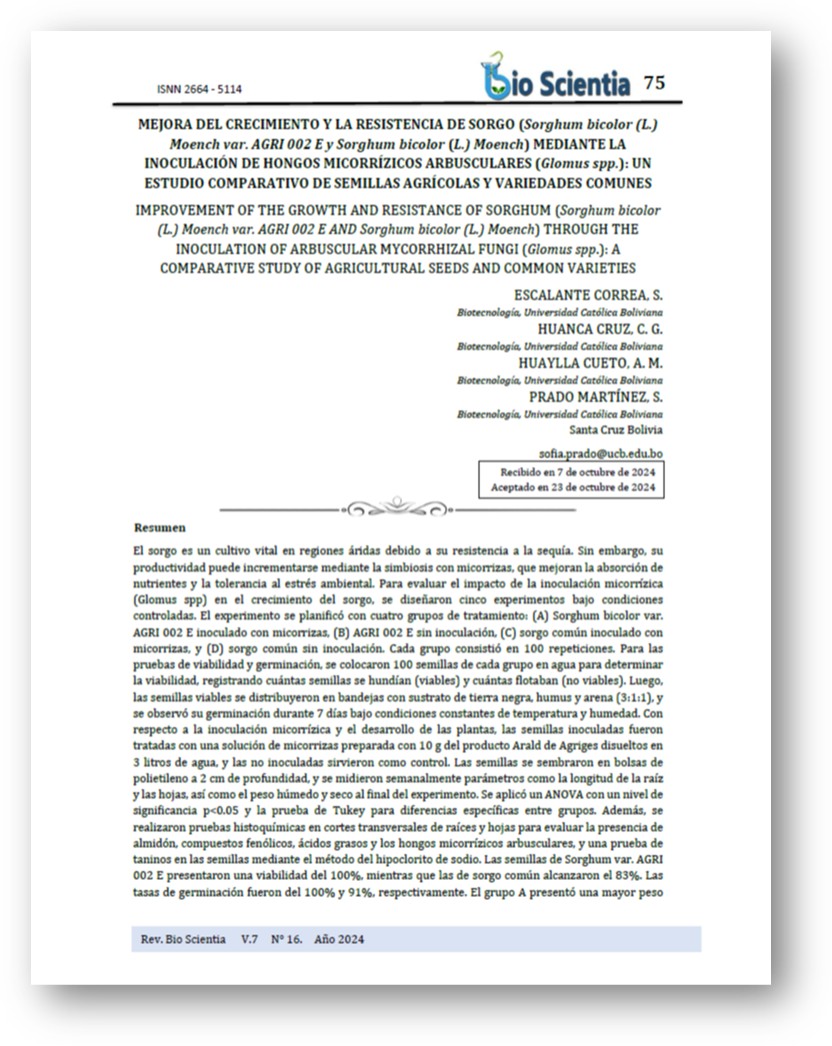IMPROVEMENT OF THE GROWTH AND RESISTANCE OF SORGHUM (Sorghum bicolor (L.) Moench var. AGRI 002 E AND Sorghum bicolor (L.) Moench) THROUGH THE INOCULATION OF ARBUSCULAR MYCORRHIZAL FUNGI (Glomus spp.): A COMPARATIVE STUDY OF AGRICULTURAL SEEDS AND COMMON V
Keywords:
sorghum, mycorrhizae, drought resistanceAbstract
Sorghum is a vital crop in arid regions due to its resistance to drought. However, its productivity can be increased by symbiosis with mycorrhizae, which improve nutrient uptake and tolerance to environmental stress. To evaluate the impact of mycorrhizal inoculation (Glomus spp) on sorghum growth, five experiments were designed under controlled conditions. The experiment was planned with four treatment groups: (A) Sorghum bicolor var. AGRI 002 E inoculated with mycorrhizae, (B) AGRI 002 E without inoculation, (C) common sorghum inoculated with mycorrhizae, and (D) common sorghum without inoculation. Each group consisted of 100 replicates. For viability and germination tests, 100 seeds from each group were placed in water to determine viability, recording how many seeds sank (viable) and how many floated (non-viable). Then, the viable seeds were distributed in trays with substrate of black soil, humus and sand (3:1:1), and their germination was observed for 7 days under constant temperature and humidity conditions. With respect to mycorrhizal inoculation and plant development, the inoculated seeds were treated with a mycorrhizal solution prepared with 10 g of the product Arald by Agriges dissolved in 3 liters of water, and the non-inoculated seeds served as a control. Seeds were sown in polyethylene bags at 2 cm depth, and parameters such as root and leaf length, as well as wet and dry weight were measured weekly at the end of the experiment. An ANOVA was applied with a significance level p<0.05 and Tukey's test for specific differences between groups. In addition, histochemical tests were performed on cross sections of roots and leaves to evaluate the presence of starch, phenolic compounds, fatty acids and arbuscular mycorrhizal fungi, and a test for tannins in the seeds using the sodium hypochlorite method. Seeds of Sorghum var. AGRI 002 E showed 100% viability, while those of common sorghum reached 83%. Germination rates were 100% and 91%, respectively. Group A showed higher average wet and dry weights, although no significant differences were found. Significant differences were found in leaf and root length (p<0.05), with group A being the most homogeneous, obtaining the highest average values. The tannin content was 16.94% in the seeds of AGRI 002 E and 29.51% in the common variety. Histochemical tests were positive in all groups, with the exception of lactophenol blue, which was present only in the roots of groups A and C. Inoculation with Glomus spp resulted in superior growth and increased resistance, particularly in variety AGRI 002 E, underlining its potential to improve agricultural productivity under adverse conditions.



